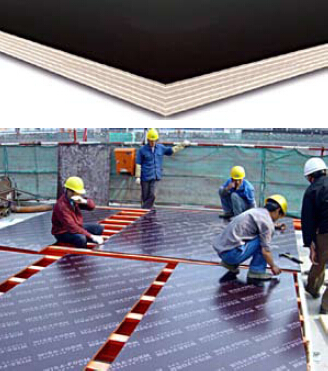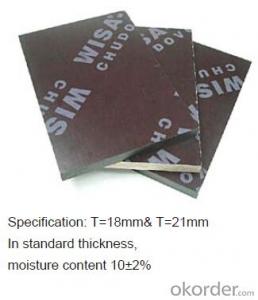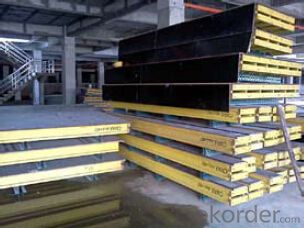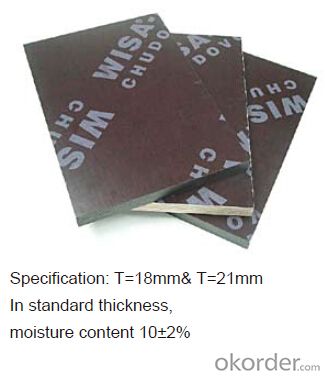Plywood formwork systems for formwork and scaffolding
- Loading Port:
- Tianjin
- Payment Terms:
- TT OR LC
- Min Order Qty:
- 50 m²
- Supply Capability:
- 1000 m²/month
OKorder Service Pledge
Quality Product, Order Online Tracking, Timely Delivery
OKorder Financial Service
Credit Rating, Credit Services, Credit Purchasing
You Might Also Like
Plywood --- make perfect concrete surface
WISA-Form Birch is a coated special plywood using in the formwork systems where high
requirements are set on the concrete surface and the times of reuses.
With CNBM timber beam & WISA plywood, the formwork is low weight but high load capacity, it is
widely used in construction.
Characteristics:
◆ Component with high standardization.
◆ Assembling in site, flexible application.
◆ Light weight, easy transportation and storage.


- Q: How does steel formwork handle formwork stripping and repositioning?
- Steel formwork is a highly durable and versatile option for handling formwork stripping and repositioning. It is designed to withstand the pressure exerted during the concrete pouring process and can easily handle the removal of the formwork once the concrete has set. When it comes to formwork stripping, steel formwork offers several advantages. Firstly, it provides a smooth surface finish to the concrete, ensuring a high-quality end result. The steel panels are typically coated with a protective layer, which prevents concrete from sticking to the formwork and facilitates easy stripping. The steel formwork system is engineered to allow for quick and efficient formwork removal. This is achieved through the use of various mechanisms such as wedge clamps, pins, or hooks, which securely hold the formwork panels in place during the pouring process. Once the concrete has achieved sufficient strength, these mechanisms can be easily released, allowing for smooth and effortless stripping of the formwork. Moreover, steel formwork can be easily repositioned and reused for multiple construction projects. The modular design of steel panels allows for flexibility in adjusting the formwork to different dimensions and shapes. This reusability significantly reduces the overall cost of formwork, making it a cost-effective solution for construction projects. Additionally, steel formwork offers excellent strength and stability, ensuring that the structure remains intact during the entire process of formwork stripping and repositioning. This is particularly important in high-rise or complex structures where the formwork needs to withstand significant loads and pressures. In summary, steel formwork is a reliable and efficient choice for handling formwork stripping and repositioning. Its durability, ease of use, and adaptability make it a preferred option for construction projects of various scales and complexities.
- Q: How does steel formwork compare to plastic formwork?
- Steel formwork and plastic formwork are two commonly used types of formwork systems in construction projects. Each has its own advantages and disadvantages, making them suitable for different applications. Steel formwork is known for its durability and strength. It can withstand heavy loads and is ideal for large-scale projects that require repetitive use of formwork. Steel formwork has a longer lifespan compared to plastic formwork, making it a cost-effective choice in the long run. It can be easily customized to meet specific project requirements, allowing for flexibility in design. Additionally, steel formwork provides a smooth finish to concrete surfaces, which reduces the need for additional finishing work. On the other hand, plastic formwork offers several advantages over steel formwork. Plastic formwork is lightweight, making it easier to handle and transport. This results in faster installation and dismantling times, which can increase overall project efficiency. Plastic formwork is also resistant to corrosion and does not require surface treatment or maintenance. It is reusable and recyclable, making it an environmentally friendly option. Additionally, plastic formwork has good insulation properties, which can help reduce energy consumption in buildings. In terms of cost, steel formwork is generally more expensive than plastic formwork upfront due to the higher material and manufacturing costs. However, the long lifespan of steel formwork and its ability to be reused multiple times offset the initial cost, making it a cost-effective choice for projects with a high volume of concrete pouring. In conclusion, the choice between steel formwork and plastic formwork depends on the specific requirements of the project. Steel formwork is suitable for large-scale projects that require durability and strength, while plastic formwork is more suitable for smaller projects that require faster installation and dismantling times. Both options have their own advantages and disadvantages, and it is important to consider factors such as cost, project timeline, and design flexibility when making a decision.
- Q: What is the maintenance required for steel formwork?
- The maintenance required for steel formwork primarily involves cleaning and proper storage. After each use, it is important to clean the steel formwork thoroughly to remove any concrete residue or debris. This can be done using water and a brush or pressure washer. Additionally, any rust spots should be treated with a rust converter and painted to prevent further deterioration. Proper storage is also crucial for maintaining steel formwork. It should be stored in a dry and well-ventilated area to prevent moisture buildup and rusting. If possible, the formwork should be stored off the ground to minimize contact with moisture. Regular inspections should be conducted to identify any damages or wear and tear on the steel formwork. Any bent or damaged components should be repaired or replaced to ensure the formwork remains in good working condition. Overall, maintaining steel formwork involves regular cleaning, proper storage, and inspections to ensure its longevity and effectiveness in construction projects.
- Q: I would like to ask the bridge column (D110) steel template thickness should be how much
- The bridge column (D110) column die steel template if the combination of the steel mold, the control panel in 3-5mm more appropriate, to determine the main force depends on the template and rib spacing, material selection.
- Q: What is the maximum concrete pressure that steel formwork can withstand?
- The ability of steel formwork to withstand the maximum pressure of concrete depends on various factors, including the specific design and construction of the formwork system. However, when compared to other types of formwork materials, steel formwork generally has the capacity to withstand higher concrete pressures. Typically, the maximum concrete pressure that steel formwork can endure ranges from 50 to 100 kilonewtons per square meter (kN/m²) or 7.2 to 14.4 pounds per square inch (psi). This level of pressure is suitable for a wide range of construction projects, such as high-rise buildings, bridges, and other structures that involve substantial concrete pours. It is worth noting that the determination of the maximum concrete pressure that steel formwork can withstand should always be carried out by a qualified engineer or designer. They will take into account factors like the height and thickness of the concrete pour, the arrangement and dimensions of the formwork supports, and the strength and stability of the steel formwork system. By adhering to the recommended limits for maximum concrete pressure, construction professionals can ensure the safety and integrity of the formwork system. This will help minimize the risk of failure or collapse and ensure the successful pouring of concrete.
- Q: What are the common applications of steel formwork?
- Steel formwork finds widespread use in the construction industry for a variety of purposes. Several typical applications of steel formwork are as follows: 1. Concrete construction: Steel formwork is commonly employed to cast concrete structures such as walls, slabs, columns, and beams. It offers a sturdy and rigid framework that holds the concrete in place until it solidifies and achieves sufficient strength. 2. High-rise buildings: Due to its durability and strength, steel formwork is frequently utilized in the construction of tall buildings. It can withstand the pressure and weight of the concrete, ensuring the stability and safety of the structure. 3. Bridges and tunnels: Steel formwork is also employed in building bridges and tunnels. It allows for the precise shaping of concrete elements like piers, abutments, and tunnel linings, guaranteeing the structural integrity and functionality of these infrastructure projects. 4. Industrial structures: The extensive use of steel formwork can be observed in the construction of industrial facilities such as factories, warehouses, and power plants. It provides a robust framework capable of withstanding heavy loads and adverse working conditions. 5. Water retaining structures: Constructing water tanks, reservoirs, and swimming pools often involves the use of steel formwork. It ensures accurate pouring and curing of the concrete to prevent any water leakage or seepage. 6. Architectural features: Steel formwork is also employed to create intricate architectural features like decorative facades, curved walls, and unique shapes. Its flexibility allows for precise molding and shaping of concrete to achieve the desired design aesthetics. 7. Infrastructure projects: Steel formwork is indispensable for various infrastructure projects such as dams, tunnels, culverts, and retaining walls. It provides a sturdy framework that supports the concrete during construction, ensuring the long-term stability and functionality of these structures. In summary, steel formwork is an integral part of the construction industry, offering a reliable and efficient method for casting concrete structures in a wide range of applications. Its strength, durability, and flexibility make it a popular choice for numerous construction projects.
- Q: Can steel formwork be used for architectural construction projects?
- Yes, steel formwork can be used for architectural construction projects. Steel formwork offers several advantages such as durability, versatility, and reusability, making it a suitable choice for various architectural applications. It provides a strong and rigid structure that can withstand the concrete pressure during casting, allowing for the creation of complex shapes and designs. Additionally, steel formwork can be easily assembled, dismantled, and adjusted, enabling efficient construction processes and reducing overall project timelines.
- Q: How does steel formwork compare to wooden formwork?
- Steel formwork is often considered superior to wooden formwork due to its numerous advantages. Firstly, steel formwork is highly durable and can withstand heavy loads and repeated use. It does not warp, crack or split like wooden formwork, ensuring a longer lifespan and reduced maintenance costs. Moreover, steel formwork provides greater accuracy and precision in construction. Its rigid structure ensures that the desired dimensions and shapes are maintained, resulting in better-quality finishes. In contrast, wooden formwork can be more challenging to align and may result in slight variations or imperfections in the final product. Steel formwork also offers increased efficiency and productivity. It can be easily assembled, disassembled, and moved to different locations, reducing construction time and labor costs. Additionally, steel formwork requires minimal cleaning and maintenance, eliminating the need for constant repairs or replacements like wooden formwork. Furthermore, steel formwork is more resistant to moisture and weather conditions. It does not absorb water or warp when exposed to rain or humidity, making it suitable for use in various climates. Wooden formwork, on the other hand, can degrade when exposed to moisture, potentially affecting the structural integrity of the construction. Although steel formwork may require a higher initial investment than wooden formwork, its long-term benefits outweigh the costs. It provides greater durability, accuracy, efficiency, and resistance to environmental factors, making it a preferred choice in modern construction projects.
- Q: How does steel formwork handle different concrete workability levels?
- Steel formwork is a versatile and durable material that can effectively handle different concrete workability levels. Workability refers to the ease with which concrete can be mixed, placed, compacted, and finished. When dealing with concrete of different workability levels, steel formwork offers several advantages. Firstly, its strong and rigid structure can withstand the pressure exerted by concrete during pouring and compaction. This ensures that the formwork remains stable and does not deform or collapse under the weight of the concrete. Additionally, steel formwork provides a smooth and uniform surface for the concrete, regardless of its workability. This is crucial for achieving a high-quality finish and minimizing defects such as honeycombing or uneven surfaces. The smoothness of steel formwork allows for easy and efficient removal, ensuring that the concrete retains its shape and integrity. Moreover, steel formwork can be easily customized and adjusted to accommodate different workability levels. Its modular nature allows for easy assembly and disassembly, making it suitable for various construction projects and concrete types. Steel formwork can be adjusted to accommodate changes in concrete consistency, ensuring that the formwork remains tight and secure. This adaptability is particularly beneficial when working with concrete mixes that have different slump values or consistencies. Another advantage of steel formwork is its reusability. Unlike other types of formwork, such as wooden or plastic formwork, steel formwork can be used multiple times without compromising its structural integrity. This not only reduces construction costs but also allows for efficient handling of concrete with different workability levels. Steel formwork can be easily cleaned, repaired, and reused, making it a cost-effective and sustainable choice for handling various concrete workability levels. In conclusion, steel formwork provides a reliable and adaptable solution for handling different concrete workability levels. Its strength, smoothness, adjustability, and reusability make it an ideal choice for ensuring the stability, quality, and efficiency of concrete construction projects.
- Q: How does steel formwork affect the concrete pouring process?
- Steel formwork plays a crucial role in the concrete pouring process by providing a sturdy and reliable support structure for the wet concrete. It offers several advantages over other types of formwork, such as timber or plastic. Firstly, steel formwork is highly durable and can withstand the pressure exerted by the wet concrete without warping or deforming. This ensures that the formwork maintains its shape and dimensions, resulting in a finished concrete structure that is accurate and precise. This is particularly important for projects with complex shapes or intricate designs. Additionally, steel formwork is reusable, making it a cost-effective solution for construction projects. Unlike timber or plastic formwork, steel can be used multiple times, reducing the overall project expenses. It also contributes to sustainability by minimizing waste and reducing the environmental impact associated with disposable formwork materials. Another advantage of steel formwork is its ability to provide a smooth surface finish to the concrete. The steel panels are manufactured with high precision, resulting in a uniform and even surface texture on the poured concrete. This is particularly beneficial for projects that require a high-quality finish, such as architectural structures or exposed concrete surfaces. Furthermore, steel formwork offers excellent stability and support during the pouring process. Its rigid structure prevents any movement or shifting of the formwork, ensuring that the concrete is poured accurately and evenly. This is crucial for maintaining the structural integrity of the concrete and preventing any potential defects or weaknesses. In summary, steel formwork significantly affects the concrete pouring process by providing durability, reusability, smooth surface finish, and stability. It ensures that the concrete structure is formed accurately and precisely, resulting in a high-quality finished product.
Send your message to us
Plywood formwork systems for formwork and scaffolding
- Loading Port:
- Tianjin
- Payment Terms:
- TT OR LC
- Min Order Qty:
- 50 m²
- Supply Capability:
- 1000 m²/month
OKorder Service Pledge
Quality Product, Order Online Tracking, Timely Delivery
OKorder Financial Service
Credit Rating, Credit Services, Credit Purchasing
Similar products
Hot products
Hot Searches
Related keywords




















